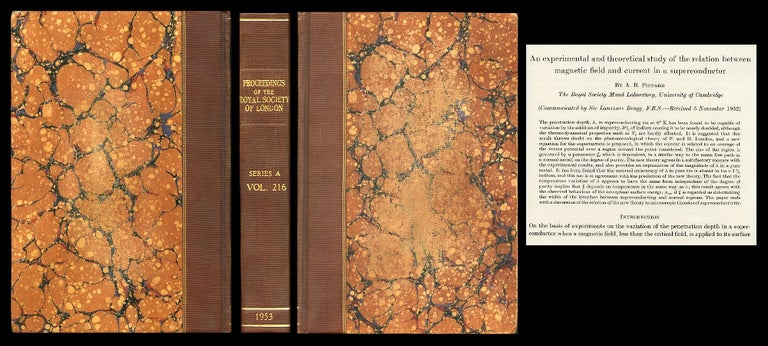An Experimental and Theoretical Study of the Relation Between Magnetic Field and Current in a Superconductor in Proceedings of the Royal Society 216, 1953, pp. 547-568
London: Royal Society, 1953. 1st Edition. BOUND FIRST EDITION OF PIPPARD’S DISCOVERY OF THE COHERENCE LENGTH. “Loosely speaking, the coherence length can be viewed as the spatial distance over which the superconducting state (i.e., electron-electron pairing length scale) can exist” (Ray, Superconductors, 35). The significance of this is that, according to the theory, only electrons with a particular energy level contribute to superconductivity. This was a key breakthrough leading to the BCS theory of superconductivity.
Professor Sir Brian Pippard was Cavendish Professor of Physics at the University of Cambridge for the majority of his career. While at Cambridge and based upon his thesis work on the anomalous skin depth in dirty superconductors, Pippard proposed “that the character of superconductivity changes at short distances, below a scale he named the coherence length. Pippard showed that, at these short distances, the local London relation between current and vector potential is replaced by a non-local relationship. Pippard’s result means that Ginzburg-Landau theory is inadequate at distances shorter than the coherence length, demanding a microscopic theory” (Coleman, Introduction to Many-Body Physics, 489).
In 1948, Fritz London, in a paper entitled “On the Problem of the Molecular Theory of Superconductivity” (and which we offer separately and in wraps) proposed what would become known as the ‘London Moment’: his prediction that a spinning superconductor would develop a magnetic dipole which was exactly aligned with the instantaneous spin axis and whose magnitude is proportional to the spin speed. Put another way, “the phenomenological London equations may be consequences of the coherence of a quantum state” (Wikipedia). The paper we offer suggests that Pippard’s experiments threw “doubt on the phenomenological theory of F. and H. London”; a new equation for the supercurrent is proposed (Pippard, 1953, p. 547).
Leading directly to the BCS theory in 1957, Pippard’s 1953 paper shows that “superconducting electrons behave in a rigid way over a length of about a micrometer [the coherence length]. The behavior is rigid in the sense that, if you give the electrons a push at one point, (by applying an external force, say an electric field), they all move in the same direction and at the same speed up to a distance of about a micrometer from where you apply a force” (Saxena, High-Temperature Superconductors, 200). Item #893
CONDITION & DETAILS: London: The Royal Society. Complete volume. 4to. 9.75 by 7 inches (213 x 138mm). [4], xv, [586], 4. The volume is illustrated throughout with in-text figures. Small, light ex-libris stamp on the title page. Handsomely rebound; gilt lettered at the spine. The marbled paper boards were purposefully scuffed by the binder in order that the book, though rebound, appears somewhat aged. Solidly and very tightly bound. Bright and clean throughout. Fine condition.
Price: $475.00

